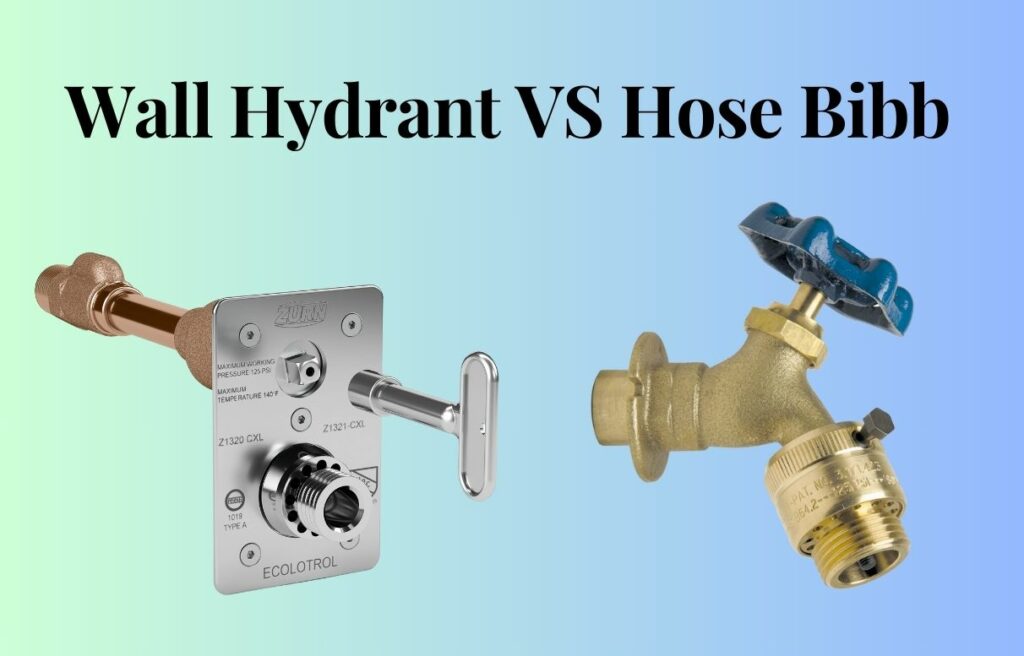
Wall hydrants are typically used in commercial and industrial settings. They are more durable than hose bibbs and can withstand higher water pressure. Wall hydrants also have a longer spout, which makes them easier to use for filling buckets or watering large areas.
Hose bibbs are more commonly used in residential
settings. They are smaller and less expensive than wall hydrants, but
they are also less durable. Hose bibbs are typically used for watering
lawns and gardens, washing cars, and filling swimming pools.
What are the differences between a Wall Hydrant and a Hose Bibb
Wall hydrants and hose bibbs are both outdoor water faucets. they both used to connect hoses to. However, there are some key differences between the two.
Appearance
Wall hydrants are typically larger and more industrial-looking than hose bibbs. They are also usually mounted on an exterior wall of a building. While hose bibbs can be mounted on the side of a house or on a separate post.
Function
Wall hydrants are designed to provide a high volume of water flow. And hose bibbs are designed for lower-volume applications, such as watering plants or washing cars.
Security
Wall hydrants typically have a locking mechanism that prevents unauthorized use, while hose bibbs do not. This makes wall hydrants a better choice for areas where theft is a concern.
Freeze protection
Wall hydrants are designed to be freeze-proof, while hose bibbs are not. This is because wall hydrants have a long stem that extends into the house, where it is protected from freezing temperatures.
In general, wall hydrants are a better choice for commercial or industrial applications where a high volume of water is needed. Hose bibbs are a more common choice for residential applications.
pros and cons of wall hydrant
Pros:
- High water flow: Wall hydrants are designed to provide a high volume of water flow, making them ideal for filling pools, washing cars, or watering large lawns.
- Security: Wall hydrants typically have a locking mechanism that prevents unauthorized use, making them a good choice for areas where theft is a concern.
- Freeze protection: Wall hydrants are designed to be freeze-proof, as they have a long stem that extends into the house, where it is protected from freezing temperatures.
- Durability: Wall hydrants are made from durable materials, such as brass or cast iron, and are built to withstand heavy use.
- Aesthetics: Wall hydrants can add a touch of elegance to a home’s exterior, especially when they are made from high-quality materials and finished to match the home’s style.
Cons:
- Cost: Wall hydrants are typically more expensive than hose bibbs.
- Installation: Wall hydrants can be more difficult to install than hose bibbs, as they require access to the plumbing behind the exterior wall.
- Maintenance: Wall hydrants may require more maintenance than hose bibbs, as they may need to be lubricated or have their seals replaced periodically.
- Limited water flow control: Wall hydrants typically do not have a lot of water flow control, so it can be difficult to get a precise stream of water.
- Not suitable for all applications: Wall hydrants are not suitable for all applications, such as watering delicate plants or washing windows, as they can provide too much water pressure.
pros and cons of hose bibbs
Here are the pros and cons of hose bibbs:
Pros:
- Low cost: Hose bibbs are typically less expensive than wall hydrants.
- Easy installation: Hose bibbs are relatively easy to install, even for DIYers.
- Low maintenance: Hose bibbs require minimal maintenance.
- Good water flow control: Hose bibbs typically have good water flow control, making them ideal for watering delicate plants or washing windows.
- Suitable for a wide range of applications: Hose bibbs are suitable for a wide range of applications, from watering plants and washing cars to filling pools and washing windows.
Cons:
- Low water flow: Hose bibbs are designed for low-volume applications, so they may not be suitable for filling pools or washing large lawns.
- Not secure: Hose bibbs do not typically have a locking mechanism, making them vulnerable to theft.
- Not freeze-proof: Hose bibbs are not designed to be freeze-proof, so they may freeze in cold climates.
- Limited durability: Hose bibbs are not as durable as wall hydrants and may need to be replaced more often.
- Aesthetics: Hose bibbs can be unsightly, especially when they are made from cheap materials or are not well-maintained.
What Are the Main Differences Between a Wall Hydrant and a Hose Bibb?
When comparing a wall hydrant and a hose bibb, it’s important to understand their differences. A wall hydrant is designed for outdoor use and has a shut-off valve farther into the building. On the other hand, a hose bibb is typically used for connecting hoses and is located closer to the exterior of a building. For more information on plumbing fixtures, check out a comprehensive guide to delta shower valves.
Is It Necessary to Have a Wall Hydrant or Hose Bibb for Proper Toilet Installation?
When installing a toilet, having a wall hydrant or hose bibb is not necessary. Instead, focus on properly securing the toilet with the right tools and materials. One of the ways to check toilet bolts is to ensure they are tight and secure to prevent any leakage or movement.
Which type of faucet is right for me?
The best outdoor water faucet for you depends on your needs and preferences. If you need a high-volume, secure, and freeze-proof water source, then a wall hydrant is the best option.
If you need a low-cost, easy-to-install, and low-maintenance water source, then a hose bibb is the best option.

Leave a Reply